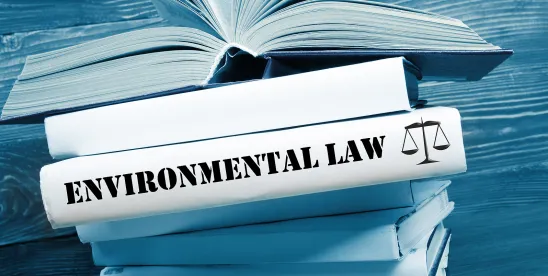Key Takeaways
- Despite the Trump administration’s elimination of federal environmental justice (EJ) programs, states are reaffirming their commitment to EJ and pushing forward new EJ programs and policies.
- There are signs that the Trump administration may seek to challenge state EJ programs, either directly or by challenging actions taken by private parties to comply with those programs. Actions taken by the administration to date suggest that it has several tools at its disposal, including the False Claims Act (FCA), constitutional challenges, withholding federal funds, and objections to state-issued permits.
- Given continuing obligations under state EJ laws, private companies should be wary of future state-federal conflict regarding EJ policies and how to manage their company’s compliance risk. Private companies seeking to comply with state EJ programs will need to consider how to manage associated risks if the federal government seeks to take action in this area.
States Filling the Federal EJ Void
Over the last few months, the U.S. has witnessed a complete reversal of federal EJ policy—the era of unprecedented federal prioritization of EJ has been replaced by one in which the federal government has become actively antagonistic to its prior policies. Even while facing this animosity, however, state EJ proponents are not backing down: Thirteen state attorneys general (AGs) recently issued the Multi-State Guidance Affirming the Importance and Legality of EJ Initiatives (State Guidance) condemning the “chilling effect” that federal actions have had on EJ initiatives. In the State Guidance, the AGs rebuked the federal characterization of EJ policies, programs, and activities as “illegal discrimination,” asserting that the “[t]he President cannot unilaterally prohibit lawful state, Tribal, and local policies, programs and activities to advance environmental justice.” The 13 states—led by California, Massachusetts, and New York and joined by Arizona, Connecticut, Delaware, Hawaii, Illinois, Maryland, Minnesota, Oregon, Rhode Island, and Vermont—reaffirmed their commitment “to implement[ing] and enforce[ing] the nation’s laws to advance environmental justice” and “to defend[ing] [EJ] efforts across the United States.”
While the federal void created by this administration’s shifted position on EJ is new, state action on EJ is not. In 2020, New Jersey passed the nation’s first law on broad EJ permitting, which prohibits the New Jersey Department of Environmental Protection (DEP) from granting or renewing environmental permits for certain facilities until DEP determines that there are neither disproportionate nor cumulative environmental impacts on EJ communities. Since then, at least eight other states have implemented similar laws. For example, New York passed its EJ permitting law, Environmental Conservation Law Section 70‑0118, in March 2023. Updated as recently as 2024, the law prohibits state regulators from issuing permits that may contribute “more than a de minimis amount of pollution to any disproportionate pollution burden” on an EJ community. Other permitting laws, such as Connecticut’s Public Act 23-202, require a community environmental benefit agreement whereby the permit applicant provides financial resources to the relevant municipality to mitigate impacts related to the applicant’s facility.
Beyond EJ permitting laws, states have developed other laws and programs to promote EJ. Several states, including California, Colorado, Connecticut, Illinois, Maryland, New Jersey, and Washington, developed EJ mapping tools to identify communities disproportionately affected by environmental burdens. Washington State’s 2021 Healthy Environment for All (HEAL) Act requires certain state agencies to take specified actions, such as allotting to EJ communities 40% of environmental benefit-creating expenditures; New York has adopted similar legislation. Also in 2021, Pennsylvania established its Office of Environmental Justice, which works to “ensure the fair treatment and meaningful involvement of all people with the development, implementation, and enforcement of environmental policies, regulations, and laws.”
Despite EJ’s disfavor at the federal level, states continue to push forward on EJ in 2025. In January, Pennsylvania’s legislature introduced new EJ legislation, H.B.109, which would grant the Pennsylvania DEP the power to deny permit applications based on cumulative environmental impacts to an EJ community. New York released proposed amendments to its State Environmental Quality Review Act regulations to require agency environmental reviews to consider the pollution burden on EJ communities. The following month, the Maryland legislature introduced the CHERISH (Cumulative Harms to Environmental Restoration for Improving our Shared Health) Our Communities Act, which would give the Maryland Department of the Environment the authority to consider EJ in its permitting decisions.
In addition to legislative activity, states continue to incorporate EJ into enforcement efforts and suit remedies. For example, in a Clean Air Act suit, Massachusetts AG Andrea Joy Campbell recently secured a settlement that designated $155,00 into Massachusetts’s Environmental Justice Trust.
Looking Ahead: Possible State and Federal Standoff on EJ
Since the start of his second term, President Trump has implemented several executive orders (EOs) indicating that the federal government will act against state laws related to climate change and diversity, equity, and inclusion (DEI). Although the EPA has traditionally defined EJ as the “fair treatment and meaningful involvement of all people regardless of race, color, national origin, or income with respect to the development, implementation, and enforcement of environmental laws, regulations and policies,” the Trump administration often equates EJ to DEI and, at times, climate change policy. While they are distinct concepts, EJ has nevertheless fallen into the crosshairs of this administration’s anti-DEI and climate actions.
For example, EO 14173, Ending Illegal Discrimination and Restoring Merit-Based Opportunity, requires all agencies to include in every federal contract and grant: (1) a requirement for contractors and grantees to certify that they are not “operat[ing] any programs promoting DEI that violate any applicable Federal anti-discrimination laws”; and (2) a requirement for contractors and grantees to certify their compliance with Federal anti‑discrimination laws for purposes of the FCA. The U.S. Office of Personnel Management has accordingly issued a memorandum to heads of federal departments and agencies stating that DEI initiatives are unlawful when they take “action motivated, in whole or in part, by protected characteristics.” EJ could potentially be swept into the scope of the EO if one views ensuring fair treatment under environmental policies regardless of race, color, or national origin as “motivated . . . by protected characteristics.”
Further, on May 19, 2025, U.S. Deputy AG Todd Blanche issued a memorandum launching the “Civil Rights Fraud Initiative.” Blanche directs the U.S. Department of Justice (DOJ) to use the FCA to “investigate and, as appropriate, pursue claims against any recipient of federal funds”—which include federal contractors and grantees—“that knowingly violates federal civil rights laws.” Per the memorandum, a knowing violation of federal civil rights law would include government contractors or grantees that “certify compliance with civil rights laws” while employing DEI programs “that assign benefits or burdens on race, ethnicity, or national origin.” Blanche encourages both private parties and federal enforcement staff to pursue FCA qui tam whistleblower suits, which private parties can initiate and allow a whistleblower to share in up to 30% of recovered monetary relief. Such private suits could substantially augment the number of enforcement actions against contractors and grantees.
On June 27, 2025, the Office of Federal Contract Compliance Programs (OFCCP) issued a letter to federal contractors inviting voluntary submissions on their efforts to “wind down” affirmative action programs and ensure compliance with non-discrimination laws. EO 14173 gave contractors until April 21, 2025 to end implementation of affirmative action programs. Now, OFCCP asks for voluntary confirmation. Such initial soft requests for data may set the stage for more significant federal action; the Trump administration has followed a similar pattern in engaging with universities and law firms regarding their DEI policies, as discussed below.
Taken together, federal actions related to EO 14173 confirm the Trump administration’s treatment of EJ programs as DEI programs, thus subjecting EJ programs to the same elevated litigation risk. EPA’s announcement of contract cancellations, which touts the agency as saving nearly $60 million from “wasteful DEI and environmental justice initiatives,” suggests that the agency lumps the two concepts together.
The administration also targeted EJ efforts through its revamped climate and energy policy. EO 14260, Protecting American Energy From State Overreach, requires DOJ to identify all state and local laws “burdening” domestic energy resources that “are or may be unconstitutional, preempted by Federal law, or otherwise unenforceable.” The EO expressly directs DOJ to prioritize state laws that address climate change, ESG (environmental, social, and governance), and EJ and “expeditiously take all appropriate action to stop the enforcement of” such laws.
Despite these federal actions, several states have indicated their intent to stand firm on climate issues. In response to EO 14260, New York Gov. Kathy Hochul and New Mexico Gov. Michelle Lujan Grisham, co-chairs of the U.S. Climate Alliance, said that they “will keep advancing solutions to the climate crisis.” The Office of California State AG Rob Bonta similarly stated that his office “remains committed to using the full force of the law and tools of this office to address the climate crisis head-on and protect public health and welfare.” In addition to the above-mentioned guidance issued by thirteen state AGs, Shawn LaTourette, head of New Jersey’s DEP, stated that New Jersey and other states will continue to “step out” on the EJ issue.
What Could a State-Federal Conflict Look Like for EJ?
Similar state-federal conflicts over climate and DEI policy can provide insights into how such a conflict could play out in the EJ space. On the climate front, the Trump administration has thus far focused on states as actors, by suing New York and Vermont for their “Superfund” laws and suing Hawaii and Michigan to stop them from suing major oil companies for contributing to climate change. Consistent with the themes of EO 14260, in each complaint, the federal government has alleged that the states are “stand[ing] in the way” of the “national effort to secure reliable sources of domestic energy.”
Regarding DEI policies, the Trump administration has already begun to target private organizations. For example, the Trump administration’s ongoing feud with Harvard University began with an attempt to investigate the university’s DEI practices. Since then, the administration has threatened or implemented funding cuts and freezes, investigations, and other sanctions, such as President Trump’s proclamation purporting to block new international students from enrolling at Harvard. Beyond educational institutions, the administration has also targeted law firms. The administration’s battle with law firms has included issuing sanctions via EOs, presidential memoranda, and letters from the Equal Employment Opportunity Commission. While not all actions by the administration relate to firms’ DEI practices, DEI was among the administration’s listed grievances.
Potential tools that the administration may deploy against EJ efforts include enforcing the FCA, constitutional challenges, withholding federal funds, and objecting to state-issued environmental permits.
- Under the Civil Rights Fraud Initiative, DOJ may use the FCA to investigate and pursue federal contractors and grantees that “knowingly violate civil rights laws.” As discussed above, the Trump administration has, to some extent, lumped together DEI and EJ policies. In Deputy AG Blanche’s memorandum on the initiative, he suggested simply having a DEI program as a federal contractor or grantee may be enough for DOJ action. This initiative further increases litigation risk through the qui tam provision of the FCA, which enables whistleblowers to file suit on the government’s behalf. DOJ could target private businesses that make certifications to the federal government as contractors or grantees, citing their participation in state EJ programs or the businesses’ own EJ programs
- Constitutional challenges are another tool at the administration’s disposal, as indicated in EO 14260 and evidenced in the lawsuits against New York, Vermont, Hawaii, and Michigan. Of particular note in the EJ space are potential equal protection claims. States and private entities should be cognizant of how they define EJ communities and whether those definitions heavily rely on protected characteristics like race. Given the administration’s aversion to disparate-impact laws, EJ policies that lack careful wording may increase litigation risk.
- Perhaps the tool that is most within the Executive’s discretion is the ability to withhold federal funds. The EPA has already warned states not to use federal funds on EJ programs—although it remains unclear how the federal government would determine whether states are doing so. Additionally, the administration has attempted to cancel EJ grants that the Biden administration had awarded to private organizations. However, a federal court has vacated the administration’s cancellation of those grants and sent back the decision to EPA for further review.
- The federal government also has the power to review and object to permits issued under EPA delegations. For example, under the Clean Air Act, state permitting authorities must submit proposed permits for EPA review, and EPA can object to permits that do not satisfy applicable requirements under the Act. EPA’s ability to take such action over objections to EJ permit requirements has not yet been tested, but it soon could be. The EPA is currently considering a petition asking it to object to a New Jersey Clean Air Act permit on the ground that the permit invalidly imposes EJ requirements on the permittee.
Given the rapid developments in the EJ space, private companies may be confused about whether their legal obligations or litigation risk have shifted. To the extent state EJ laws impose requirements on the regulated community, those obligations remain unchanged. While it is not yet clear the extent to which the Trump administration is willing to go after private companies for their EJ policies or compliance with state EJ programs, the administration’s actions suggest it is not outside the realm of possibility. Federal contractors or grantees with DEI or EJ policies should carefully review their policies and evaluate potential risks. While only states will face the litigation risk of constitutional challenges to EJ laws, private companies will still have to contend with any uncertainty about applicable law that might result from such litigation and possible EPA objections to state permits. Nevertheless, private companies should continue to comply with their existing legal obligations and remember that EJ is a valuable tool for engaging with communities.
Katrina Oshima contributed to this article





 />i
/>i

